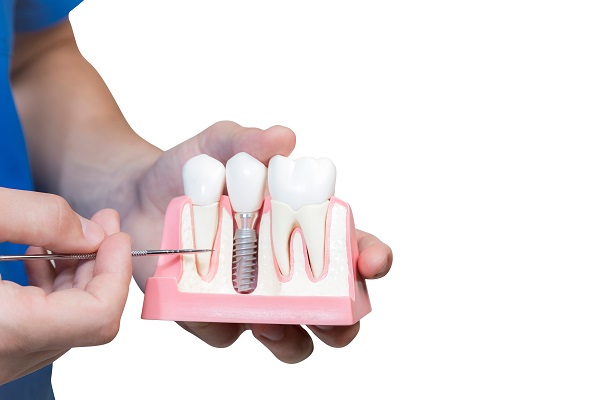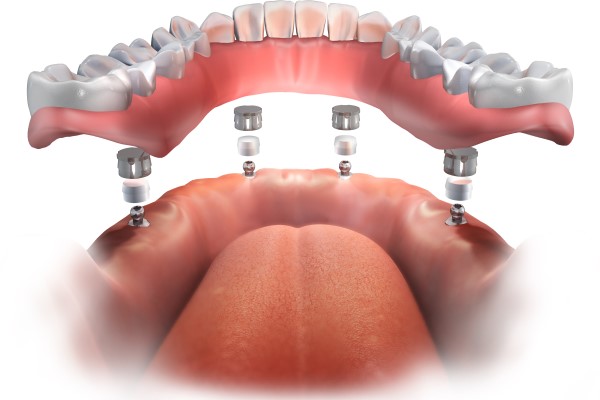How Is a Dental Implant Placed?

The placement of dental implants is an intricate process involving the insertion of titanium posts into the jawbone. The posts mimic the functions of the natural tooth roots by fusing to the jawbone and support the replacement tooth attached to them. The process involves multiple dental implants, but the process is generally worth the trouble. Continue reading to get an overview of what is involved in placing dental implants.
The implant procedure
The number of missing teeth determines the number of implants required. Only one implant is needed for a lost tooth, and four to six implants may be used to support an entire arch of missing teeth.
The process of placing one dental implant lasts between 30 to 60 minutes and about two to three hours for multiple implants. The patient’s condition will determine the length of the procedure and the number of appointments needed. The dentist will perform the needed assessment to obtain information about the patient’s situation.
Before the placement, patients may be administered a course of antibiotics, and intravenous sedation or nitrous oxide might be used to ensure comfort. The dentist will discuss these options during the initial consultation. A local anesthetic will be used around the point of implant placement.
When the patient is at ease, the dentist will create a little incision over the gum tissue to access the bone, open the space with dental tools, and insert the implant post. The head of the implant will protrude slightly through the gum. The dentist may choose to allow the gum tissue to cover the implant completely. The gum tissues will be stitched closed to complete the implant placement.
After the procedure
The healing period follows the implant placement process. The duration is hardly the same for everyone and depends on the health and quantity of the bone. Patients may experience slight pain after the procedure, but the dentist will prescribe medications to relieve the pain. If self-dissolving stitches are not used, patients will return to get the stitches taken out.
Sometimes, a restoration may be attached immediately after implant placement. The dentist will provide suggestions on follow-up care and appointments. After the bone heals around the implant – a process which may take between three to six months – the dentist will place the abutment or a healing cap on the implant. This will guide the gum tissue healing, and the abutment will serve as the connection between the restoration and the implant.
The dentist will take dental impressions and send them to a dental lab to produce the dental crown. Follow-up appointments allow the dentist to monitor healing progress and determine when the time is right to attach the dental restoration. The implant procedure ends once the crown is fitted over the dental implant.
In conclusion
The placement of dental implants is a multi-stage process. Considering that implant restorations look, function, and feel like natural teeth, the lengthy process is usually worth it. If you are considering the procedure, book an appointment with the dentist to discuss eligibility and the process.
Request an appointment here: https://englishdentalky.com or call English Dental at (502) 200-0204 for an appointment in our Louisville office.
Check out what others are saying about our dental services on Yelp: Dental Implants in Louisville, KY.
Related Posts
Dental implants are long-lasting, permanent tooth replacements. They are a popular choice among patients for their durability and ability to look and feel like natural teeth. However, dental implants are an investment, and they should be cared for as such. Follow the tips below to help extend the life span of your implants and prevent…
Dental implants replace missing teeth and help with chewing, speaking, and smiling. They can consist of titanium or a combination of titanium and ceramic materials. Dental implants serve as anchors for artificial replacements: full dentures, partial dentures, dental crowns, and bridges. If you are considering dental implants, this guide will help you know what to…
Those missing teeth and seeking a way to restore their smile should consider dental implants. Dentists and their patients are discovering the many benefits of this tooth-replacement over other options, such as dentures and bridges. If you are missing one or more teeth like so many adults, dental implants offer a way to restore your…
Dental implants are a leading choice for many patients when it comes to tooth replacement. Patients like the idea of a tooth replacement option resembling natural teeth. Dental implants look natural and perform like a permanent natural tooth. Therefore, there is no need to take the tooth replacement out daily for cleaning or worry about…


